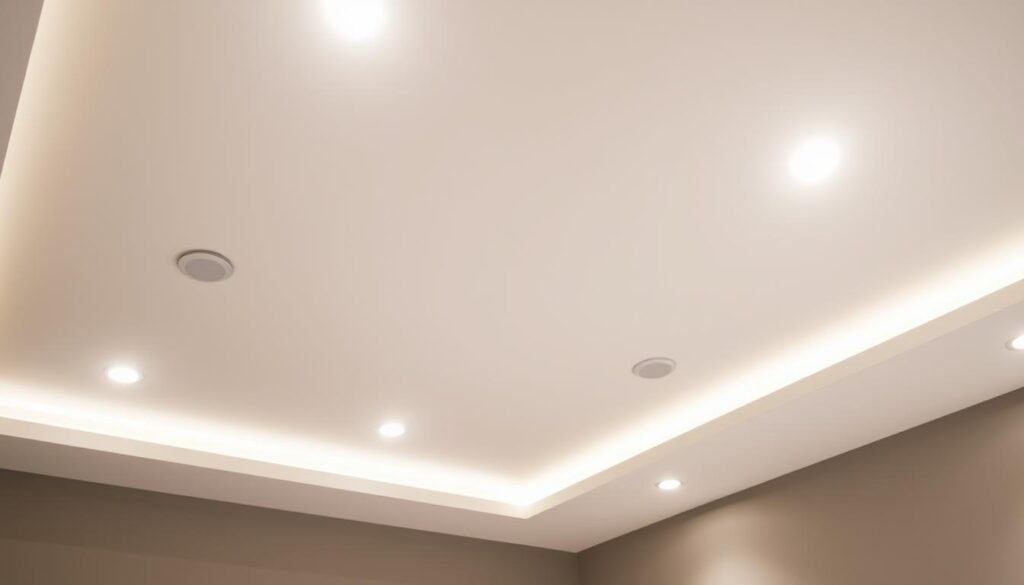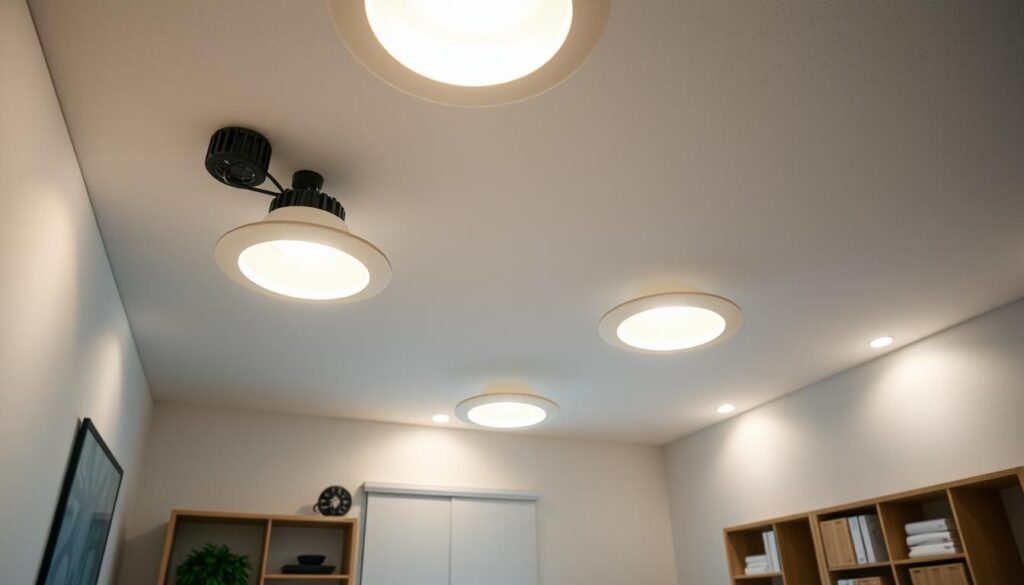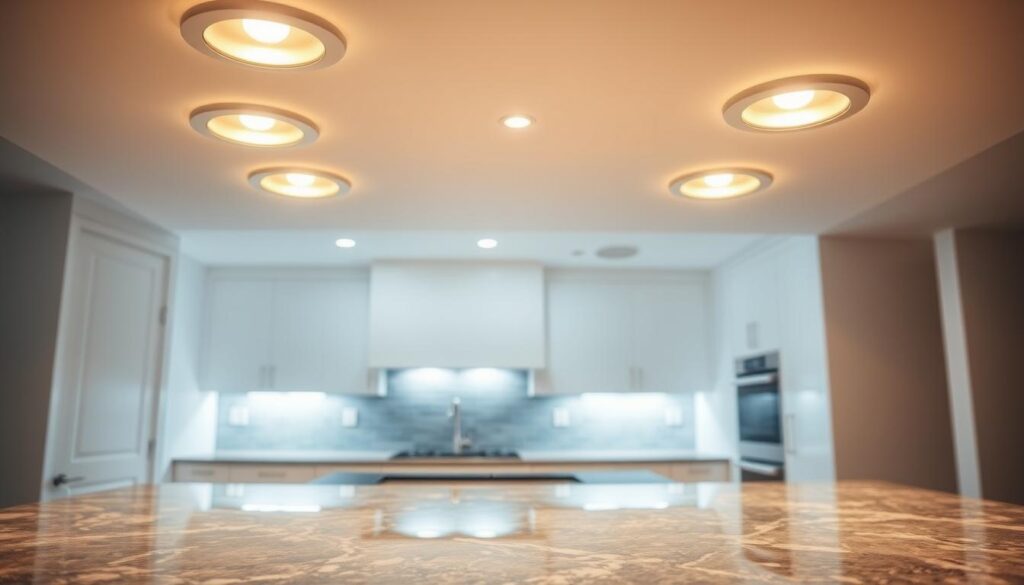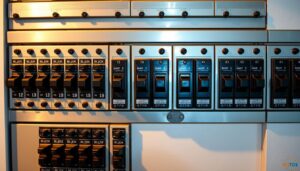Many homeowners face challenges when trying to create a well-lit and inviting atmosphere, especially when traditional recessed lighting isn’t feasible due to ceiling constraints.
Surface-mount LED downlights offer a versatile and elegant solution, providing both functional illumination and aesthetic appeal. Unlike traditional recessed options, they require minimal ceiling modification, making them ideal for retrofitting existing spaces or rental properties.
With various designs, finishes, and technical specifications available, modern surface-mount LED downlights can suit different interior styles and lighting requirements. This comprehensive guide will walk you through selecting, planning, installing, and maintaining these energy-efficient lighting solutions.
Key Takeaways
- Surface-mount LED downlights are ideal for homes where recessed lighting isn’t feasible.
- They offer both functional illumination and aesthetic appeal.
- Minimal ceiling modification is required for installation.
- Various designs and technical specifications are available to suit different interior styles.
- Proper installation can enhance your living space while reducing electricity consumption.
Understanding Surface-Mount LED Downlights
When it comes to lighting your home, surface-mount LED downlights offer a versatile and efficient solution. These lighting fixtures are designed to be attached directly to the ceiling surface, making them ideal for spaces where recessed lighting is not feasible.
What Are Surface-Mount LED Downlights?
Surface-mount LED downlights are lighting fixtures that attach directly to your ceiling surface. They typically consist of an aluminium housing, an LED light source, and a diffuser to create even light distribution. These modern lighting solutions are perfect for homes with concrete ceilings or limited space above ceiling panels.
Benefits Over Recessed Lighting Options
Unlike traditional recessed lighting, surface-mount downlights require no complex ceiling modifications. This significantly reduces installation time and potential structural issues. The energy efficiency of LED technology means these fixtures consume up to 80% less electricity than traditional halogen alternatives while providing the same or better illumination.
Common Types and Styles Available
Surface-mount LED downlights come in various designs, from minimalist cylinders to linear bars, complementing any interior design style. Most are rated IP20, suitable for dry indoor environments. They are available in different finishes such as white, black, and brushed aluminium.
Choosing the Right Surface-Mount LED Downlights for Your Space
When it comes to selecting the perfect surface-mount LED downlights, several factors come into play to ensure you achieve the desired ambiance and functionality in your home. Understanding these elements will help you make an informed decision.
Key Technical Specifications to Consider
Technical specifications play a crucial role in determining the performance of your surface-mount LED downlights. Key factors include wattage, lumens, colour temperature, and beam angle.
Wattage and Lumens
Wattage indicates the power consumption of your LED downlights, typically ranging from 5-10W for residential use. Lumens measure the actual light output; look for fixtures offering 70-100 lumens per watt for optimal efficiency.
Colour Temperature and Beam Angle
Colour temperature, measured in Kelvins, determines the light’s appearance: 2700-3000K provides warm white light ideal for living areas, while 4000-5000K delivers cooler light better suited for task-oriented spaces. Beam angle affects light distribution, with narrow beams creating focused effects and wider beams providing general illumination.
Design and Finish Options
Surface-mount downlights come in various finishes, including white, black, brushed aluminium, and electroplated options. The finish can complement different interior styles, from modern to traditional.
Compatibility with Your Home’s Décor
Consider the fixture’s physical dimensions and profile height, especially in spaces with low ceilings. For contemporary homes, cylindrical or square downlights with clean lines work well. Ensure your chosen fixtures align with your overall lighting design concept, considering how they’ll interact with other light sources and architectural features.
Planning Your Lighting Layout
To create a harmonious lighting scheme, you need to decide on the number of downlights and their ideal locations. Effective lighting layout planning begins with understanding your space’s specific needs.
Determining the Optimal Number of Lights
A general rule of thumb is to use one downlight per 1.5 to 2 square metres for ambient lighting in residential settings. This guideline helps in achieving a balanced lighting effect.
Ideal Placement for Different Room Types
The placement of downlights varies depending on the room’s purpose. For instance, in living rooms and bedrooms, you may want to highlight specific areas or create ambient lighting.
Living Rooms and Bedrooms
In living rooms, position downlights to highlight key features such as artwork or architectural elements. In bedrooms, a combination of task lighting near dressing areas and softer ambient lighting around the bed is ideal.
Kitchens and Hallways
Downlights in kitchens should be positioned directly above worktops and cooking areas to eliminate shadows. In hallways, evenly spaced downlights at intervals of approximately 1-1.5 metres provide consistent lighting.
Creating Lighting Zones and Effects
To enhance the ambiance, create distinct lighting zones by grouping downlights on separate circuits. This allows for independent control of different areas for various activities and moods.
| Room Type | Ideal Downlight Placement | Recommended Spacing |
|---|---|---|
| Living Rooms | Highlight key features and seating areas | 1.5 to 2 metres |
| Kitchens | Above worktops and cooking areas | 1 to 1.5 metres |
| Hallways | Evenly spaced along the hallway | 1 to 1.5 metres |

How to Fit Surface-Mount LED Downlights: Step-by-Step Guide
To ensure a successful installation of surface-mount LED downlights, follow this step-by-step guide. Fitting these downlights can significantly enhance your home’s ambiance and functionality.
Tools and Materials You’ll Need
Before beginning the installation, gather all necessary tools including a drill, screwdriver set, wire strippers, voltage tester, measuring tape, pencil, and appropriate screws and wall plugs for your ceiling type.
Safety Precautions Before Installation
Safety must be your priority—always turn off power at the consumer unit/fuse box and verify with a voltage tester that the is dead before commencing any electrical work. If you’re not a qualified electrician, consider hiring a professional to avoid electrical hazards and potential warranty invalidation.
Installation Process
The installation involves several key steps.
Preparing the Mounting Surface
Ensure the mounting surface is clean, dry, and structurally sound. Repair any damaged plasterboard and remove flaking paint before installation.
Connecting to Your Home’s Electrical System
Identify the circuit you’ll be using and ensure it can handle the additional load. The LED driver must be correctly connected to both the mains power and the light fixture.

Use appropriate fixings for your ceiling material and ensure the fitting is firmly attached without overtightening, which could damage the housing.
| Step | Description | Tools Required |
|---|---|---|
| 1 | Mark positions for downlights | Pencil, Measuring Tape |
| 2 | Prepare mounting surface | Drill, Screwdriver |
| 3 | Connect to electrical system | Wire Strippers, Voltage Tester |
| 4 | Secure downlight fixture | Screwdriver, Wall Plugs |
Enhancing Your Lighting Setup
By making a few adjustments, you can enhance the functionality and aesthetic appeal of your surface-mounted LED downlights. One effective way to do this is by incorporating dimmer controls, allowing you to adjust the light intensity to suit different activities and create varying atmospheres throughout the day.
Adding Dimmer Controls for Flexibility
When selecting dimmable downlights, ensure compatibility between your LED fixtures, dimmer switch technology, and LED drivers to prevent issues such as flickering or premature failure of components. Dimmable surface-mount LED downlights offer flexibility in lighting control.
Combining with Other Lighting Types
Create layered lighting by combining your surface-mounted downlights with other light sources, such as floor lamps or wall sconces, to add depth and eliminate harsh shadows. This approach can also help in achieving a more balanced lighting environment.
Smart Home Integration Options
Modern smart lighting systems can transform your surface-mounted downlights into an intelligent network controlled via smartphone apps or voice commands. Popular smart lighting options include systems from Philips Hue, LIFX, and Lightwave, offering features like remote control and colour changing capabilities.
For maximum energy efficiency, consider pairing your LED downlights with motion sensors in areas like hallways and utility rooms. This ensures that lights are only active when spaces are occupied, reducing unnecessary energy consumption.
Maintenance and Troubleshooting
Proper care and troubleshooting can significantly extend the life of your surface-mounted LED downlights. These lights are designed to provide a minimum of 20,000 hours of maintenance-free lighting, making them a reliable choice for your home.
To keep your LED downlights functioning optimally, regular maintenance is essential. This involves simply dusting the fixtures with a soft, dry cloth after ensuring they’re switched off and cool to touch. Avoid using liquid cleaners that might damage the electrical components or finish.
Some common issues with LED downlights include flickering, uneven colour output, and overheating. Flickering often indicates compatibility issues between the LED driver and your home’s electrical system. Uneven colour between multiple downlights might suggest manufacturing variations, and reputable suppliers should replace units with significant discrepancies under warranty.
If your downlight stops working, first check the power supply by testing the circuit and checking fuses or circuit breakers. For persistent issues, consult the product’s technical specifications or contact the manufacturer directly, as most quality products come with multi-year warranties covering manufacturing defects.
By following these maintenance and troubleshooting tips, you can enjoy the benefits of your surface-mounted LED downlights for years to come, with their energy efficiency and long lifespan making them a cost-effective lighting solution.



